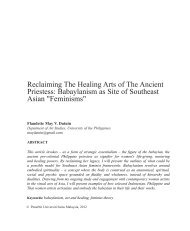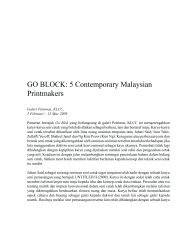Preservation of Traditional Art: The Case of the ... - Wacana Seni
Preservation of Traditional Art: The Case of the ... - Wacana Seni
Preservation of Traditional Art: The Case of the ... - Wacana Seni
You also want an ePaper? Increase the reach of your titles
YUMPU automatically turns print PDFs into web optimized ePapers that Google loves.
11Takako IwasawaRevitalisation <strong>of</strong> Tradition among Amateurs<strong>The</strong> Thai government has stimulated interest in nooraa among pr<strong>of</strong>essionals and ordinarypeople by au<strong>the</strong>nticating it as tradition, introducing it into <strong>the</strong> education system and promotingit as a tourist attraction. As a result <strong>of</strong> cultural education, <strong>the</strong> local people who used to make up<strong>the</strong> audience have transformed <strong>the</strong>mselves into performers. <strong>The</strong> last section <strong>of</strong> this paper looksat how amateur performers are maintaining <strong>the</strong> traditional art form.Local cultural educationAccording to Craig Reynolds (1991), <strong>the</strong> editor <strong>of</strong> <strong>the</strong> book “National Identity and ItsDefenders: Thailand, 1939–1989”, <strong>the</strong> Thai government has supported those kinds <strong>of</strong> musicand dance that are considered part <strong>of</strong> traditional Thai culture, actively introducing <strong>the</strong>m into<strong>the</strong> national education system. <strong>The</strong>y have continued this effort by promoting <strong>the</strong> concept <strong>of</strong>ekkalak Thai (Thai identity) to <strong>the</strong> nation, in hopes <strong>of</strong> protecting Thai culture against foreignthreats (Reynolds 1991: 4–14). During <strong>the</strong> late 1970s, <strong>the</strong> Office <strong>of</strong> <strong>the</strong> Prime Minister beganissuing a monthly magazine entitled Thai Identity (ekkalak Thai) (Reynolds 1991: 13).Since <strong>the</strong>n, education in traditional performance genres has become widespread throughout<strong>the</strong> country. At <strong>the</strong> same time, <strong>the</strong> idea <strong>of</strong> Thai identity became a popular slogan among <strong>the</strong>citizens. During <strong>the</strong> 1980s, <strong>the</strong> demand for traditional Thai art performances increased becausegovernment policy linked traditional arts with <strong>the</strong> tourist industry.In <strong>the</strong> 1970s, schools throughout <strong>the</strong> country started introducing traditional Thai culture into<strong>the</strong>ir general curriculum. For example, primary and middle schools introduced <strong>the</strong> teaching <strong>of</strong>traditional Thai dance and music as a mandatory or elective course. <strong>The</strong> higher educationalinstitutions such as <strong>the</strong> Teacher’s College <strong>of</strong> Thai Dance and Music, as well as <strong>the</strong> fine artsdepartments at several universities, are now actively introducing Thai traditional arts courses.
















